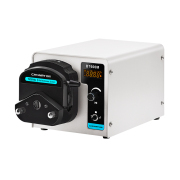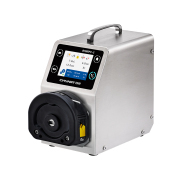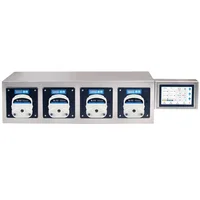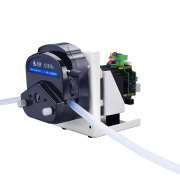Chonry Peristaltic Pump
Peristaltic Dispensing Pump
Peristaltic Dispensing Pump
Depending on the model and application, a peristaltic dispensing pump can be a versatile tool for the accurate and efficient transfer of liquids.peristaltic dispensing pump Its simple design and low moving parts make it ideal for sterile or chemically sensitive liquids. Besides being durable, these pumps can also be adapted to fill a specified volume.
A peristaltic dispensing pump uses rollers that compress the tube and induce suction. The pump is capable of handling both viscous and corrosive liquids. It has the advantage of being easy to clean and maintain. It also offers accurate volume control and the ability to handle a wide range of liquids.
A peristaltic pump can be used for a wide range of applications, including chemical dosing, metering, water treatment and warewashing. It can be used with a wide variety of tubing materials to meet the flow requirements of your application. In addition to meeting these requirements, the pump tubing has chemical compatibility and is simple to disinfect after use. It also reduces contamination of the product.
A peristaltic dispensing pumps can be operated by a powerful motor. This provides repeatability and better than 0.25 percent speed control accuracy. It also helps in integrating the pump into an automated system. In addition, it enhances user comfort during repetitive dispensing applications. Other features include remote control options. There are options for prime and reverse. In addition, there are dispensing wands for momentary start and stop. These features are especially helpful in applications where repetitive dispensing is required.
There are two types of peristaltic pumps: the fixed occlusion pump and the spring-loaded roller pump. In a fixed occlusion pump, the occlusion wall is fixed. The wall is a crescent shape, which is adjustable for pressure. When the wall is adjusted, it helps to overcome variations in tube wall thickness. It also helps in generating higher flow rate. In a spring-loaded pump, the occlusion wall is not fixed, and the pressure varies according to the thickness of the tube wall. The rollers in a spring-loaded pump are more elaborate than those in a fixed occlusion pump.
Compared to a fixed occlusion pump, a spring-loaded pump offers greater accuracy. The occlusion wall can be adjusted to change the pressure, which means that the pump can be used to handle a wide range of liquids. The pumping action is also more gentle, which is ideal for shear-sensitive fluids. It also reduces damage to blood cells.
A pump head can be purchased separately if desired. The pump head is also available in stacked models that are equipped with offset rollers to reduce pulsation. In addition, it can be stacked with other heads to unite flow channels. Depending on the configuration of your application, you can choose between a single-channel head, a multichannel head or a cartridge pump head.
The pump tubing is also available in single-use versions that allow for the direct transfer of product from a holding tank to a filling nozzle. The tubing is lined with a sterile filter, and it may also be available in quick-connect fittings for septic applications.
0users like this.







